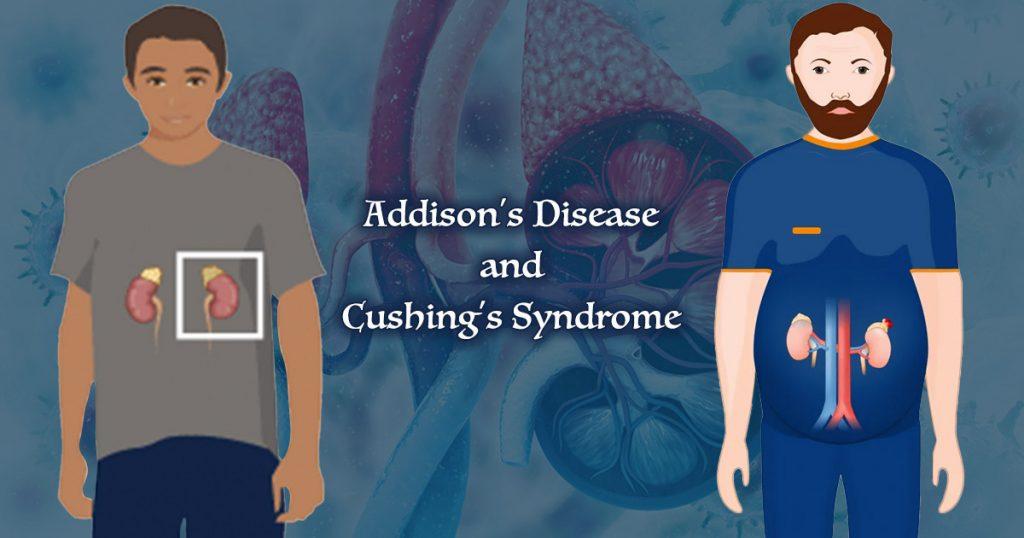When your adrenal glands, tiny organs sitting above your kidneys, aren’t working right, they can cause some big problems. These glands make important hormones like cortisol and aldosterone that help regulate everything from how your body responds to stress to your blood pressure. If they make too much or not enough of these hormones, you could end up with health issues.
Although it’s pretty rare to have problems with your adrenal glands, it’s something to keep an eye on. Stressful lifestyles or taking certain strong medications for a long time can increase your chances. Statistics reveal that about 4 to 11 per 100,000 people get Addison’s disease, and Cushing’s syndrome happens in about 10 to 15 out of every million people every year.
These conditions remind us how important it is to keep everything in balance inside our bodies. They bring us to two different problems that come from the same place: the adrenal glands not doing their job right, called Addison’s Disease and Cushing’s Syndrome. Even though they come from similar issues, they affect the body in very different ways and need their own specific treatments.
What is Addison’s Disease?
Addison’s Disease happens when your adrenal glands don’t make enough of certain vital hormones, like cortisol and aldosterone. This leads to several issues, such as:
- Feeling very tired all the time
- Losing weight without trying
- Having weaker muscles
- Experiencing low blood pressure
- Seeing darker areas on your skin
- Feeling more thirsty
- Wanting to eat salty foods
This condition can start because your immune system attacks your adrenal glands by accident. It can also happen due to infections, genetic problems, or injuries to these glands. The disease gets its name from Thomas Addison, a doctor from the 1800s who first connected these symptoms to adrenal gland problems.
What is Cushing’s Syndrome?
Cushing’s Syndrome is when your body has too much cortisol. This extra hormone can cause:
- Gaining weight mainly around your face and belly
- Having thinner arms and legs
- Skin that bruises easily
- Getting stretch marks
- High blood pressure
- Bones getting weaker
- Changes in your mood
The main reasons for this can be taking a lot of corticosteroid medicine for a long time or having tumors on your adrenal or pituitary glands. This syndrome is named after Harvey Cushing, a doctor who first described these particular symptoms in his patients in the early 1900s.
Understanding Addison’s Disease and Cushing’s Syndrome
Addison’s Disease and Cushing’s Syndrome are two conditions that both involve the adrenal glands but in different ways. Here’s how they are alike and different:
What They Have in Common
- Adrenal Glands: Both problems start with the adrenal glands, which are important for making hormones.
- Hormone Issues: They each cause hormone levels to be off balance—too little cortisol in Addison’s and too much in Cushing’s.
- Affects the Body: These conditions can change how your whole body works, like how you use food for energy and how your immune system fights off illness.
- Treatment: People with either condition will work with their doctors for a long time to keep their symptoms under control.
- Health Risks: If not looked after, both can lead to really serious health problems.
- Finding Out: Doctors use similar tests to figure out if someone has Addison’s or Cushing’s, like checking blood for hormone levels or using scans to look at the adrenal glands.
- Hormone Medicine: Treating both conditions often involves getting hormone levels back to normal, with medicine to replace hormones for Addison’s or treatments to lower them for Cushing’s.
How They’re Different
Symptoms:
- For Addison’s, people might feel very tired, lose weight, have low blood pressure, and see darker spots on their skin.
- With Cushing’s, people often gain weight around the middle and face, get thin skin that bruises easily, and might have high blood pressure or weak bones.
Causes:
- Addison’s usually happens because the body’s immune system attacks the adrenal glands by mistake.
Cushing’s often comes from taking certain medicines for a long time or having a tumor that makes too much cortisol.
What Treatment Looks Like:
- In Addison’s, the goal is to replace the missing hormones.
- For Cushing’s, treatment might include lowering how much medicine someone takes, surgery to remove a tumor, treatments to stop the tumor from making cortisol, or medicine to lower cortisol levels.
Living With It:
- People with Addison’s need to be careful to avoid an adrenal crisis, which is a sudden and severe worsening of symptoms that needs quick treatment.
- Those with Cushing’s may deal with issues like diabetes, high blood pressure, and mental health challenges due to too much cortisol.
In simple terms, even though Addison’s Disease and Cushing’s Syndrome both involve the adrenal glands and hormones, they go in opposite directions—one has to do with not enough of certain hormones, and the other has too much. Each has its own set of signs and ways to manage it, showing just how crucial hormones are to our health.
Cushing’s and Addison’s: Knowing Helps in Taking Action
Learning about the differences and things in common between Addison’s Disease and Cushing’s Syndrome shows us how important it is to understand health conditions well. When you know what to look out for, what causes these issues, and how they can be treated, you’re in a much better place to deal with them.
This knowledge isn’t just about making things less confusing; it’s like having a map that guides you on what steps to take next, whether that’s sticking to your medication, managing stress better, or eating foods that are good for you.
Also, being informed helps build a community of support. People going through similar health issues can share their stories and tips, making everyone feel less alone and more supported. It’s a reminder that, even though dealing with these conditions can be tough, nobody has to do it by themselves.
